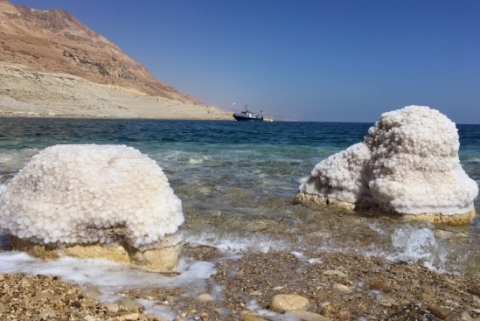
Date:
Wednesday, September 11, 2019
It’s summertime at the Dead Sea, and for locals and visitors alike enjoying the large saltwater lake shared by Israel, Jordan and Palestine, that means sun, sand and … snow?
“It’s a bit counterintuitive,” said Raphael Ouillon, a Ph.D. student in the lab of UC SantaBarbara mechanical engineering professor Eckart Meiburg. However, it is the confluence of uniqueconditions at the Dead Sea that make saltcrystal “snowfall” in the lake possible, he explained. Their work on the subject appears in the journal Water Resources Research.
With a depth of about 919 feet (280 m) and salinity above 34% and rising, thanks to evaporation and diversion of freshwater sources that once contributed to it, the Dead Sea is the deepest hypersaline lake in the world. The salt precipitation began to appear in the early 1980s, when the salinity of the lake exceeded the point of saturation.
Recently, Israeli geologist and collaborator Nadav Lensky of the Geological Survey of Israel with his team made a surprising observation regarding the precipitation of salt in summer. Suspecting their observations required additional fluid mechanics expertise, they called upon Meiburg’s group to complete the analysis of their findings, Ouillon said.
“Our research group, the Dead Sea Observatory, has set up a very unique field observatory to study the dynamics of salt deposits,” said Lensky. “The most intensive ‘snow’ of salt deposits appears in winter, due to cooling. A more surprising observation is that in summer salt dissolves in the less dense upper water layer, despite being the saltiest part of the lake. In summer, the salt ‘snow’ appears below the interface between this light top layer and dense bottom layer. We suspected that a process called ‘double-diffusive convection’ was responsible and reached out to Meiburg’s group to test our hypothesis.”


To view the complete story, please read Summer Snow by Sonia Fernandez published in The Current.
News Type:
Research



